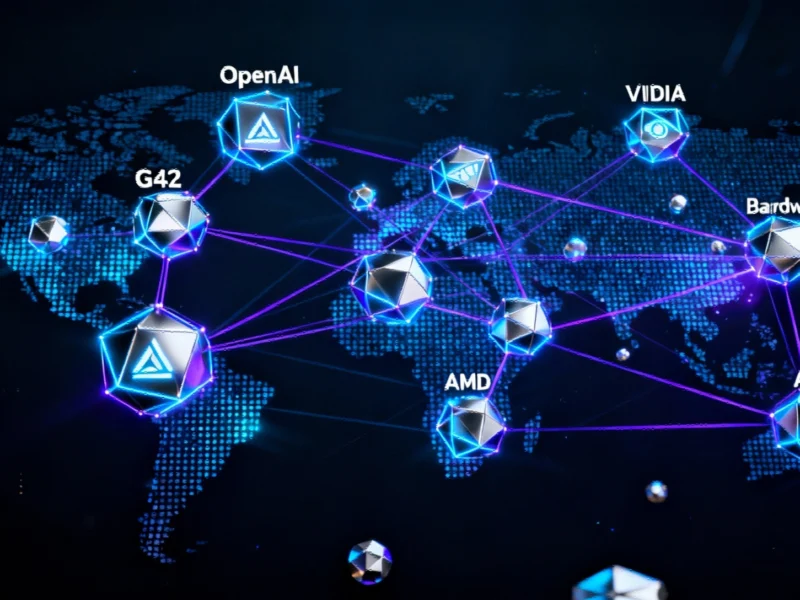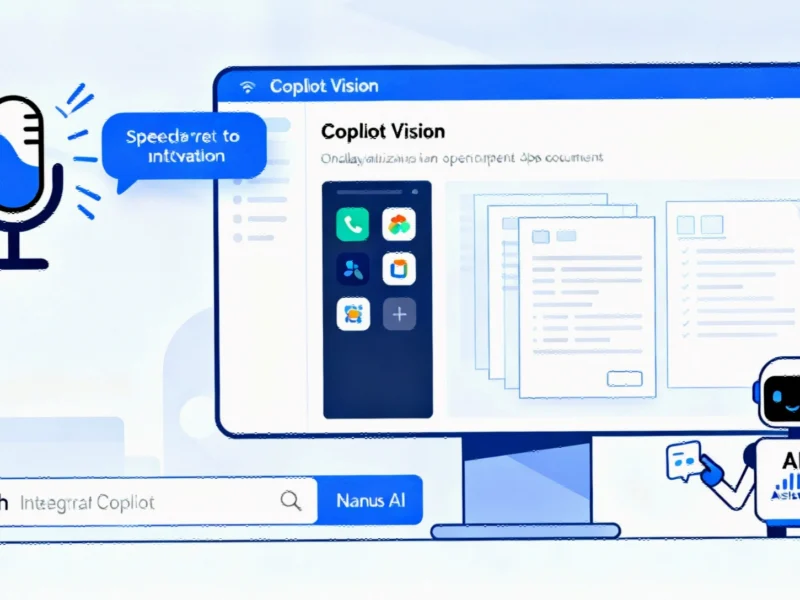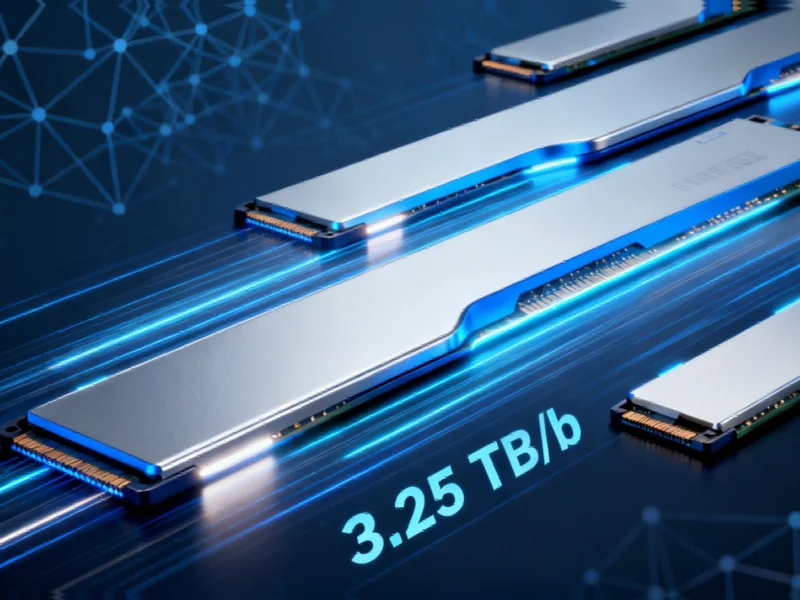Strategic Alliances Fuel Unprecedented AI Infrastructure Expansion
OpenAI is orchestrating what industry analysts are calling the most ambitious artificial intelligence infrastructure network ever assembled, with recent partnerships and agreements now totaling over $1 trillion in combined value. This massive undertaking represents a fundamental shift in how AI capabilities will be developed and deployed globally, with OpenAI positioning itself at the center of an unprecedented technological ecosystem that spans chip manufacturing, cloud computing, and international cooperation.
The scale of this expansion became clearer following OpenAI CEO Sam Altman’s recent appearance at GITEX Global 2025 in Dubai, where he discussed the future of artificial intelligence with G42’s Peng Xiao. Their conversation covered critical topics from infrastructure development to chip design and global collaboration, highlighting the interconnected nature of modern AI advancement. Peng emphasized the collaborative imperative, stating, “No company and no individual can do this alone, and that’s why we’re here sharing the stage with Sam as an equitable partner.”
Broadcom Partnership Marks Critical Infrastructure Milestone
OpenAI’s most recent strategic move involves a groundbreaking agreement with Broadcom to co-develop custom AI chips. This partnership represents a significant escalation in OpenAI’s hardware strategy, with plans to deploy enough processors to consume 10 gigawatts of electricity in the second half of next year alone. The energy requirement underscores the massive computational demands of next-generation AI systems and highlights the infrastructure challenges facing the industry.
“Partnering with Broadcom is a critical step in building the infrastructure needed to unlock AI’s potential and deliver real benefits for people and businesses,” Altman stated regarding the collaboration. He further emphasized that “developing our own accelerators adds to the broader ecosystem of partners all building the capacity required to push the frontier of AI to provide benefits to all humanity.”
Broadcom CEO Hock Tan expressed equal enthusiasm, calling the collaboration “a pivotal moment in the pursuit of artificial general intelligence.” He noted that “OpenAI has been in the forefront of the AI revolution since the ChatGPT moment, and we are thrilled to co-develop and deploy 10 gigawatts of next-generation accelerators and network systems to pave the way for the future of AI.”
Massive Deal Portfolio Reveals Comprehensive Strategy
The full scope of OpenAI’s infrastructure ambitions was detailed in an image shared on social media platform X by StockMarket.News, depicting what the outlet described as “the most expensive AI infrastructure network in history.” The visualization reveals a complex web of partnerships and agreements that collectively exceed $1 trillion in value, demonstrating OpenAI’s systematic approach to securing every layer of the AI supply chain.
Key components of this infrastructure network include:
- Stargate UAE: A $500 billion public-private project involving the U.S. government, Oracle, and SoftBank, representing the first international site in OpenAI’s global infrastructure initiative
- Nvidia Partnership: A $100 billion supply agreement for tens of thousands of GPUs to power OpenAI’s expanding computational needs
- Microsoft Alliance: The ongoing $13 billion Azure partnership that continues to form the backbone of OpenAI’s cloud computing capabilities
- AMD Collaboration: A potential $100 billion arrangement for 6 gigawatts of next-generation chips, complementing the Broadcom agreement
Circular Financing Model Underpins Expansion
Industry observers have identified what appears to be a sophisticated financial strategy driving OpenAI’s rapid infrastructure growth. StockMarket.News described the approach as “circular financing,” where GPU vendors provide funding to OpenAI, OpenAI in turn drives demand for their products through massive computational requirements, and vendors ultimately profit from the arrangement. This symbiotic relationship has enabled unprecedented scaling while raising questions about long-term sustainability.
The financing model appears particularly relevant given recent industry challenges with maintaining strategic partnerships amid political and operational pressures. OpenAI’s ability to maintain these complex relationships across multiple jurisdictions and business sectors will be critical to the network’s continued expansion.
Security and Infrastructure Considerations
As OpenAI’s infrastructure network grows in complexity and value, security considerations become increasingly paramount. The massive computational requirements and sensitive nature of AI development demand robust security protocols, particularly as recent vulnerabilities in enterprise software systems have highlighted the importance of comprehensive security frameworks for large-scale technological deployments.
These concerns are amplified by growing scrutiny of government infrastructure security and the potential implications of security breaches in critical technological systems. OpenAI’s partnerships with government entities, including the U.S. government through the Stargate project, add additional layers of complexity to security requirements and oversight.
Broader Industry Implications and Future Outlook
OpenAI’s infrastructure expansion occurs against a backdrop of significant transformation across the technology sector. The company’s current valuation has surpassed $500 billion, with its growth trajectory closely linked to nearly $3 trillion in expected data center spending through 2028. Approximately $800 billion of this investment is projected to be financed through private credit markets, indicating strong investor confidence in the AI infrastructure sector.
The scale of these developments reflects broader trends in industrial technology, where major funding rounds and strategic investments are reshaping how technology companies scale their global operations and infrastructure. As AI becomes increasingly central to economic activity, the infrastructure supporting it becomes correspondingly more critical.
However, the massive capital requirements and energy consumption of these AI infrastructure projects raise important questions about sustainability and long-term viability. With OpenAI’s network expected to consume gigawatts of electricity and require continued massive investment, industry analysts are beginning to ask how long this expansion model can be maintained before financial or operational constraints emerge.
The success of OpenAI’s trillion-dollar infrastructure network will likely depend on multiple factors: continued technological innovation, stable partnerships across the supply chain, manageable energy requirements, and sustained market demand for increasingly sophisticated AI capabilities. As this network continues to develop, it will undoubtedly shape not only OpenAI’s future but the broader trajectory of artificial intelligence development globally.
Based on reporting by {‘uri’: ‘techradar.com’, ‘dataType’: ‘news’, ‘title’: ‘TechRadar’, ‘description’: ”, ‘location’: {‘type’: ‘country’, ‘geoNamesId’: ‘2635167’, ‘label’: {‘eng’: ‘United Kingdom’}, ‘population’: 62348447, ‘lat’: 54.75844, ‘long’: -2.69531, ‘area’: 244820, ‘continent’: ‘Europe’}, ‘locationValidated’: False, ‘ranking’: {‘importanceRank’: 159709, ‘alexaGlobalRank’: 1056, ‘alexaCountryRank’: 619}}. This article aggregates information from publicly available sources. All trademarks and copyrights belong to their respective owners.



